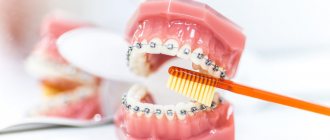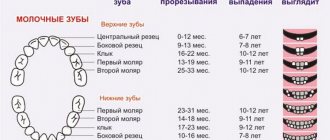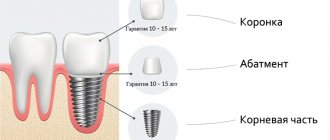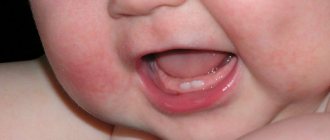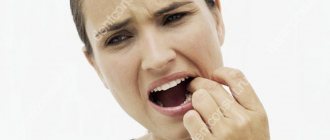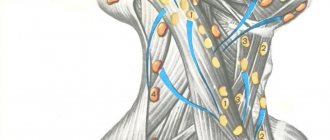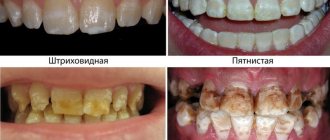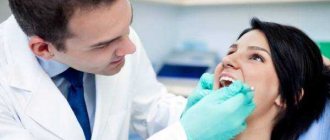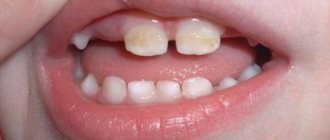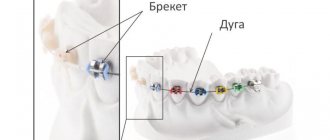1768
Bite alignment is a long procedure, during which the patient experiences discomfort and pain, which requires enormous patience.
Loose teeth are often observed. What can be done in this case, and is this situation normal? We will try to answer these questions in our article.
Problem after fixing systems
After fixing the braces, the patient may experience discomfort associated with the pressure of the clasps on the elements of the jaw row. Most often these include pain and loosening of some teeth.
Dentists explain that this phenomenon is associated with the anatomical features of the structure of the dental system.
Incisors, canines and molars are connected to the bone using elastic ligaments surrounded by dense tissue and fixed in a stationary position.
The pressure of metal or ceramic clasps causes the tooth to tilt to one side. The density of the tissue surrounding the ligaments decreases, which leads to a decrease in the stability of the position of the row elements.
Dentists note a number of factors in which loose teeth are not a pathology:
- instability of the teeth is minor;
- the phenomenon begins in the first days after installation of braces and persists throughout the entire period of orthodontic treatment;
- the gum tissue around the molars has no signs of inflammation;
- the person does not experience acute pain.
If there are any doubts about whether the phenomenon of loose teeth during bite correction is physiological, you should contact your doctor for examination and advice. This will help prevent the development of the pathological process, or carry out therapeutic measures in a timely manner.
Indications for the installation of partial braces and their types.
Come here to find out if teeth whitening is always necessary after braces.
At this address https://www.vash-dentist.ru/ortodontiya/breketyi/vestibulyarnyie/titanovyie-bezopasnost-i-rezultat.html we will discuss the pros and cons of titanium braces.
Teeth with braces are loose. Problem or pattern?
Treatment with lingual braces, ceramic self-ligating and classic metal braces is accompanied by the same adaptation processes, which cause patients some discomfort. The head hurts, the jaws ache, the orthodontic arch rubs the mucous membrane of the cheeks or gums, the tongue is injured by the sharp corners of the locks, diction may be impaired and it will be difficult to pronounce individual letters.
This is a standard situation about which potential owners of braces are well informed. But few people know that the teeth will begin to loosen.
Adults faced with such a problem panic: “ It takes so long to install braces in order to leave me without teeth?!”
In fact, even this frightening symptom fits within the standard framework. What explains the unusual mobility?
Loosen to move
When installing a turnkey bracket system , the orthodontist first of all takes care of making the teeth mobile under the traction of the orthodontic arch, after which they can be forced to move along the calculated trajectory. And if they started to stagger, it means everything is going according to plan. How is it possible to first move them from their usual position, and finally re-fix them in the jaw bone?
Teeth with braces become loose due to the coordinated work of cells such as osteoblasts and osteoclasts. The dental crown and root are connected by a ligament, which, in turn, is supported by bone tissue.
When the tooth begins to tilt under the influence of traction, the distance between the crown and the ligament increases on one side and decreases on the other. Osteoblasts begin to make up for the lack of bone tissue in order to support the tooth in a new place, and osteoclasts begin to remove the “excess” and dissolve it.
In this case, the compressed connective ligament straightens out over time, and the tooth has the full right to take the new position planned by the orthodontist.
The cycles of resorption and growth during orthodontic treatment are repeated many times, causing a kind of “rejuvenation” and strengthening of bone tissue and, of course, correcting the dentition. But since it takes a lot of time to increase tissue density, and resorption occurs faster, the teeth remain mobile for a long time.
How can I help the process?
While the tissues are weakened and the teeth are loose, it is necessary to prevent excessive stress on them.
- You should not chew whole hard carrots and hard apples, or bite caramels, nuts and seeds.
- Avoid viscous and sticky foods - dried fruits, toffees and chewing gum.
- Don't bite your nails, pens or pencils. In this way, you will not only protect weakened teeth, but also maintain the integrity of the braces system.
- Preference should be given to porridges, vegetable purees, and meat pates.
In order for bone regeneration to occur normally and the teeth to not become too loose by the time the orthodontic structure is removed, you need to include in your diet foods containing proteins, as well as all the necessary minerals and vitamins.
Is it possible not to wear retainers after braces?
Now that we understand the reason for mobility, even a patient who is mortally tired of wearing braces will no longer refuse an “unexpected” surprise - replacing them with a removable mouthguard or retainer.
It is not enough to straighten your teeth with braces . They will still have to be held in the correct positions for some time until the process of tissue regeneration is finally completed. Otherwise, freed from the powerful influence of the arc, they will begin to “spread” chaotically due to muscle memory.
The retention period, which is a mandatory stage of orthodontic treatment, can last quite a long time - up to 3-4 years.
Its duration is determined by the person’s age and the severity of the existing dental pathology.
At first, a custom-made retainer will have to be worn continuously for several months, removed for hygiene procedures. Then, on the recommendation of the attending physician, you can rest from it at night.
When teeth don't move according to plan
In some cases, during dental correction, mobility increases abnormally due to the development of osteomyelitis, osteoporosis or exacerbation of periodontal diseases (gingivitis, periodontitis and periodontal disease).
No one is immune from the development of diseases of the skeletal system. But problems with gums can result from insufficient care of braces and the oral cavity or unprofessional diagnosis at the preparatory stage. Before installing an orthodontic device, gingivitis must be treated, and periodontal disease and periodontitis must be transferred to a stage of stable remission.
In any case, the attending physician will do everything possible to eliminate the problem and minimize its consequences.
Our advantages:
Smile Studio is the first and only orthodontic center in Moscow that specializes exclusively in bite correction. We do not provide other dental services!
| Extensive experience in clinical work Several hundred patients have been treated during practice. We treat pathologies of any complexity. We work on all types of bracket systems. | Affordable prices Low cost and installment program make our offer one of the best orthodontic services on the market! | High-quality equipmentWe are the exclusive partner of the leader in the production of high-quality orthodontic products. | Convenient location We are located in the historical center of Moscow, 500 meters from the Baumanskaya metro station and the Third Transport Ring. |
| Doctor: Sudzhaev Sergey Romanovich Patient age: 25 years Diagnosis: distal occlusion, transversal incisal occlusion, crowding of the frontal sections of the upper and lower dentition, edentulous teeth 1.4;2.4;3.4;4.4. Duration of treatment: 12 months Equipment: Clarity SL bracket system | TO THE DOCTOR |
| BEFORE | AFTER |
Source: https://studia-ulybki.ru/pro-breketi/shatayutsya-zubi-s-breketami-problema-ili-zakonomernost/
Alarm bells
It is not always normal for teeth to become loose when correcting a bite. There are situations when a patient, in parallel with treatment, develops an inflammatory process in the hard or soft tissues of the oral cavity.
In order not to miss the onset of the disease, dentists recommend paying attention to the appearance of the following signs:
- redness, swelling and bleeding of the gums;
- carious lesions on the surface of molars;
- formation of erosions and ulcers on the mucous membrane;
- pathological abrasion of enamel;
- severe pain in certain areas of the jaw arch;
- the appearance of purulent discharge.
The listed signs may indicate the development of serious diseases of the teeth and gums in a person - gingivitis, periodontal disease, osteomyelitis, bruxism, osteoporosis.
These conditions require urgent treatment, since, gradually progressing, they can lead to the destruction or loss of teeth, the development of purulent-necrotic processes and fractures of the jaw bones.
Dentists note that the development of pathological conditions that cause loosening of teeth can occur for various reasons. Most often this happens due to poor oral hygiene, non-compliance with the rules of wearing braces, or injury to the jaw.
Treatment tactics
If loosening of teeth under braces is detected, accompanied by any pathological signs, the patient should immediately contact a dental center.
After clarifying the complaints, the specialist will examine the oral cavity - determine the degree of mobility of the elements, the condition of the gum tissue, and, if necessary, prescribe additional examination techniques.
If a disease requiring treatment is identified, the braces are removed and the necessary therapeutic measures are taken.
Depending on the type of pathology, they may include antibacterial and antibiotic therapy, removal of hard plaque and tissues affected by caries, and splinting of mobile teeth.
Continuation of orthodontic treatment is carried out only after the elimination of the disease that caused the pathological loosening.
Dentists point out that it is impossible to get rid of loose teeth on your own at home. Pathology requires the actions of qualified specialists.
What are fake braces and their purpose?
In this publication, you can evaluate the results of eliminating bite defects with composite braces using before and after photos of patients.
Here https://www.vash-dentist.ru/ortodontiya/breketyi/vestibulyarnyie/sapfirovyih-miso.html we will look at the design features of Miso braces.
Afterword
It is clear that loose teeth, regardless of whether they are loose with or without braces, of course, causes panic and fear. But alignment has its own characteristics and loosening is quite normal. It is thanks to this that the desired effect is often achieved.
And loosening is a must. Otherwise, the desired effect will not be achieved. It is important to survive this period by being patient and denying yourself solid food. You should also limit your consumption of sweets and use gum-strengthening rinses. If you carefully follow simple recommendations, the desired effect will be achieved.
- Materials tagged “tooth movement”
- How fast do teeth move in braces?
- Teeth loose in braces - after installing the system, the dental organs move
- How long do teeth move in braces?
Structure mobility
A fairly common situation is when an orthodontist is approached with the problem of loosening the elements of the brace system. This may be the displacement and unsticking of clasps, slipping of the orthodontic ring, or deformation of the power arch.
This often happens as a result of neglecting the rules for using braces - consuming hard foods, lack of quality care for the structure.
If any defects occur in the structure of the apparatus for correcting the bite, you must contact the specialist who fixed it.
Before the visit, loose elements should be secured with special orthodontic wax to avoid complete peeling and loss.
The specialist will examine the brace system, assess the extent of its damage and offer a solution to the problem - reinstall the loose bracket or replace it with a new one.
After removing the products
After removing the braces from the mouth at the end of the orthodontic treatment process, the patient may also experience a feeling of loose teeth. This is explained by the fact that without the pressure of the locks, the teeth tend to return to their original position.
At the same time, the tissue surrounding the ligamentous apparatus is quite plastic, so in the absence of restraining devices, the bite can deteriorate again.
Dentists insist on the need to wear special structures of a removable or non-removable type that hold teeth and ligaments in the required position - these are retainers.
The duration of wearing the devices depends on several factors - the patient’s age, the complexity of the corrected pathology, and the characteristics of the body.
As a rule, the minimum duration of the retention period is one year. In some cases, you will have to wear retainers for the rest of your life.
The video shows the mechanism for correcting bites and straightening teeth with braces.
Teeth become loose while wearing braces - what to do?
Teeth straightening is a lengthy procedure that requires a lot of patience from the patient. When wearing braces, unpleasant sensations are possible, and sometimes it happens that teeth in braces become loose. What this may be connected with and what to do in this case, we will consider in this article.
Possible difficulties when wearing braces
Even significant crooked teeth can be corrected with braces. The duration of treatment depends on the complexity of the situation.
Some patients wear braces for three years or even more. During this time, various not very pleasant situations may occur. Braces can rub and interfere with eating.
In addition, after installation of a straightening system, teeth may hurt and become loose.
Each qualified specialist should advise the patient regarding possible problems and difficulties while wearing braces. This rarely frightens the patient, because for most the dream of a beautiful smile overshadows all problems.
Mobility of the bracket system
If you do not maintain proper hygiene while wearing braces, the structure may begin to wobble. This can be caused by deformation of the archwire, unsticking or displacement of the bracket. The cause may also be a loose ring that secures the structure.
If there is any damage to the alignment structure, it is important to contact an orthodontist.
If a visit to the clinic for some reason cannot be carried out in the near future, the element that has lost its fastening strength should be secured with orthodontic wax. But you shouldn’t put off visiting the doctor too much.
In the absence of structural elements or their poor-quality fastening, load redistribution occurs, which can cause serious adverse consequences.
Causes of loosening
A patient who decides to straighten his teeth with braces begins to experience discomfort immediately after their installation. In this case, physical discomfort is accompanied by moral discomfort. And this is a normal reaction of the body.
After all, a foreign body appeared in it, and it was made of metal. It puts a lot of pressure on the jaw, can scratch, and it is prohibited to eat certain foods because of it. That is, braces create various restrictions.
Different patients get used to braces in different ways. For some, the period of adaptation lasts more than one month.
First of all, pain is felt in the jaw. It indicates the beginning of treatment and the direction of teeth to the right place. It is quite normal for your teeth to start to loosen.
After all, they have begun their movement, slowly but surely they are moving towards the right position. After all, the ligaments connecting the metal structure to the fabric are quite elastic. They hold the bone tissue, which gradually becomes more pliable and softer.
It is the decrease in tissue density that becomes a prerequisite for loosening of teeth.
Individual dental organs or all of them can become loose, which is individual for each case. After the tooth moves into a new position, it will gradually grow back and stop wobbling. That is, after removing the braces, there should be no more wobbling.
If the correction is carried out correctly, regular movement should be observed throughout its entire length. When it stops there will be no alignment. The leveling arches of the bracket system are changed and tightened several times throughout the treatment, making them increasingly tighter. When the teeth are already in the places that were planned at the beginning of treatment, we can talk about the end of the torment.
Loose teeth can be caused by reasons other than braces. They represent the following dental diseases: osteoporosis, bruxism, periodontitis, osteomyelitis, gingivitis and other ailments that are inherited.
Any orthodontic patient cannot be immune from loose teeth. But, if your teeth are very loose and you feel severe pain, it is important to consult a doctor. In such a situation, the orthodontist will assess the situation, identify the cause of such inconveniences and, if possible, eliminate them.
Looseness can also be caused by incipient periodontitis. But don't panic in advance. It is better to prepare yourself for the fact that at first there may be discomfort when wearing braces.
If your teeth are loose even after braces are removed
Braces are removed when all the teeth are in the required position. At this time, the entire jaw is tense. The teeth were subjected to forced alignment, stretching and retraction. They want to return to their original position.
Therefore, even after the braces are removed, they may continue to wobble. After all, the entire jaw, one might say, has undergone deformation. If your teeth are loose after braces, you shouldn’t panic either.
It takes time for teeth to get into shape.
Note: In order to prevent teeth from returning to their original position after braces, retainers are worn.
They should be worn until the tooth structure is completely strengthened. It usually takes more than a year for the pressure to subside from the jaw.
For an adult patient, the reasons for loose teeth after braces can be: poor diet, bad habits, insufficient amounts of proteins, high-quality fats, vitamins and carbohydrates.
If unsteadiness continues even after the retention period, the retainers are most often removed and the patient is prescribed vitamins, as well as enhanced nutrition. The tissue can grow on the teeth for up to 5 years. After this, the teeth hold well in the jaw and do not wobble.
What to do if your teeth are loose with braces?
Patients planning to correct their bite with braces are always interested in side effects. For some, they come as a surprise even when wearing braces and greatly disturb the patient.
But there is no need to worry in advance. Indeed, during the period of getting used to the structures, some unpleasant sensations can be quite normal.
They can last for a long period of time, and then go away on their own.
It is not uncommon for patients to complain of headaches, toothaches, jaw pain, as well as the fact that the dentition is loose when wearing braces. For this reason, orthodontists should tell you at the first consultation about all possible troubles during treatment.
The appearance of loose teeth while wearing appliances is quite natural and indicates that the alignment is successful. After all, the teeth are in close connection with each other and by aligning one of them, it is impossible not to affect the others. Loose teeth, headaches, and toothaches arise due to sufficient pressure on the teeth.
Therefore, there is no need to worry at all about loose teeth with braces. When the teeth are in the correct position, they will gradually wobble less, and then stop altogether. You need to be patient and wait.
However, if the unsteadiness is so severe that there are concerns about the safety of the teeth, and the discomfort from braces is very strong, you should not delay going to the dentist. To preserve your smile and make it attractive, increased vigilance will not be superfluous.
When might concern be justified?
During treatment with braces, teeth can become loose for other reasons that do not depend on the leveling structures.
If careful oral hygiene is not practiced and the patient does not follow the orthodontist's recommendations, dental disease, such as periodontal disease, periodontitis or gingivitis, may be triggered. When they become inflamed, the periodontal tissues become inflamed, the attachment of the tooth roots weakens, and the teeth begin to loosen.
Also, osteomyelitis is considered a very serious illness, which can appear if caries is not treated in a timely manner. In this case, teeth can not only become loose, they can even be lost. The disease can also spread to adjacent teeth.
In addition to loosening, the patient may also be concerned about the presence of swelling of the gums and their bleeding, as well as damage to tooth enamel by caries. If you have all these signs, it is important to immediately go to the doctor in order to start treatment on time and save your teeth.
Folk remedies to prevent loosening
The right thing to do if you notice problems with your braces is to visit an orthodontist. But, if there is a lot of time left before the visit, you can help yourself with some folk remedies. Various herbs and home remedies are used for this, but toothpaste is the best one.
You should squeeze the paste onto your toothbrush as if you were brushing your teeth normally and drop some essential oil on it (one drop will be enough). It is a natural antiseptic that is often used to protect gums from inflammation. You should brush your teeth with this solution at least twice a day.
Let's look at other folk tricks:
- Licorice root reduces plaque formation on teeth;
- Massaging the gums using turmeric, black pepper and alum helps a lot;
- Blueberry roots and hawthorn berries significantly strengthen teeth.
What do orthodontists recommend doing to reduce looseness?
Disease prevention is the best way to prevent loose teeth. To do this, it is important to watch what you eat.
It is important to have a balanced and complete diet, as well as the right amount of minerals and important nutrients.
It is important that nutrition helps strengthen the body as a whole, strengthens the immune system and resists viral infections.
The diet must contain foods containing calcium. These are beans, asparagus, beans, lentils, kefir, cottage cheese. Vitamin C is also very important, which oranges, tangerines, lemons, broccoli and sauerkraut are abundant in.
The oral cavity must certainly be in a healthy condition. Thorough cleaning at least twice a day with special brushes and rinses is important.
If there is loosening, a specialist may recommend special therapy. First, the teeth are cleaned of plaque, and then a splint is placed on the dentition (a metal wire that is attached to the back of the dentition).
Afterword
It is clear that loose teeth, regardless of whether they are loose with or without braces, of course, causes panic and fear. But alignment has its own characteristics and loosening is quite normal. It is thanks to this that the desired effect is often achieved.
And loosening is a must. Otherwise, the desired effect will not be achieved. It is important to survive this period by being patient and denying yourself solid food. You should also limit your consumption of sweets and use gum-strengthening rinses.
If you carefully follow simple recommendations, the desired effect will be achieved. The retention period should not be neglected; after retainers, the teeth will move into the right place and be overgrown with bone tissue.
It is important to take good care of your oral cavity, then any treatment will be easier.
Reviews
Complaints about tooth mobility during orthodontic treatment are quite common among patients. The cause of the phenomenon can be both the process of bite correction itself and various diseases of the teeth and gums.
Therefore, if mobility is accompanied by pain, gum inflammation or other pathological symptoms, you should consult your doctor.
Share your impressions of the process of correcting your bite with a braces system: did you feel mobility of your teeth or structure, what caused it? You can leave your answers in the comments section at the end of the article.
If you find an error, please select a piece of text and press Ctrl+Enter.
Tags: braces vestibular braces
Did you like the article? stay tuned
Previous article
What does the smell from under the crown indicate and what to do
Next article
Zirconium veneers are an ideal method for therapeutic and cosmetic restoration of the smile area
